![]()
![]()
![]()
Use LEFT and RIGHT arrow keys to navigate between flashcards;
Use UP and DOWN arrow keys to flip the card;
H to show hint;
A reads text to speech;
116 Cards in this Set
- Front
- Back
|
A tumor is "driven" by _________________.
|
DNA mutations
|
|
|
What are carcinogens?
|
Agents that damage DNA.
|
|
|
Important carcinogens include (3)?
|
(1) Chemicals
(2) Oncogenic viruses (3) Radiation |
|
|
What are aflatoxins?
|
Aspergillus can contaminate stored grains and this fungus can produce aflatoxins. Aflatoxins can increase the risk for hepatocellular carcinoma.
|
|
|
Alkylating increase the risk of ______________ and ____________.
|
leukemia; lymphoma
|
|
|
When treating cancer patients with alkylating agents (e.g. cisplatin or carboplatin), there is a risk of developing what?
|
secondary cancers like leukemias several years after treatment
|
|
|
Alcohol is associated with what types of cancers?
|
(1) SCC of the oropharynx
(2) Upper esophagus (3) Pancreatic carcinoma (alcohol can cause chronic pancreatitis) (4) Hepatocellular carcinoma (cirrhosis increases the risk for this CA) |
|
|
At the turn of the prior century, women who used to work out in the fields in England didn't want people to know that they were working in the sun (tanned skin), so they would apply arsenic to their skin to make it pale. They were at increased risk for what?
|
(1) SCC of the skin
|
|
|
How would you test for arsenic poisoning?
|
Clip the finger nails or remove the hair. Arsenic can be found in these samples.
|
|
|
Exposure to arsenic would make you susceptible to what kinds of cancer?
|
(1) SCC of the skin
(2) Lung cancer (arsenic is in smoke) (3) Angiosarcoma of liver |
|
|
A source of asbestos would be?
|
(1) Insulation around pipes in naval ships
(2) Roofing material, ceiling tiles (takflis), floor tiles used > 20 years ago (3) Demolition of old buildings |
|
|
These mineral dusts are very fibrogenic.
|
Silica, asbestos, beryllium.
|
|
|
Asbestos come in two geometric forms. What are they? What are their significance?
|
(1) Serpentine
• Curly, flexible fibers. • Produces interstitial fibrosis, lung cancer (2) Amphibole • Straight, rigid fibers • Produces interstitial fibrosis, lung cancer, mesothelioma |
|
|
Asbestos fibers coated by iron and protein are called __________.
|
ferruginous bodies
|
|
|
Exposure to asbestos is more likely to lead to what type of cancer involving the lungs?
|
Lung cancer, not mesothelioma.
|
|
|
Exposure to asbestos increases the risk for _________ and ___________.
|
(1) Lung CA
(2) Mesothelioma |
|
|
Cigarette smoke increases the risk for carcinoma what (5)?
|
(1) CA of the oropharynx
(2) Esophagus (3) Lung (4) Kidney (5) Bladder |
|
|
How many people worldwide smoke?
|
1 billion people
|
|
|
What is the most common carcinogen worldwide?
|
Cigarette smoke
|
|
|
The most important carcinogen in smoke is?
|
Polycyclic hydrocarbons
|
|
|
The key risk factor for urothelial carcinoma is ___________.
|
cigarette smoke. Carcinogens are concentrated in the urine, bathing the urothelium in the process. Over a period of years, urothelial CA may ensue.
|
|
|
Nitrosamines are highly associated with ___________. It is found in ____________ foods.
|
stomach carcinoma; smoked
|
|
|
This carcinogen is responsible for the high rate of stomach cancer in Japan.
|
Nitrosamines
|
|
|
What type of stomach carcinoma could you get from ingesting nitrosamines over long time?
|
Intestinal type of stomach carcinoma (most common type of gastric adenocarcinoma)
|
|
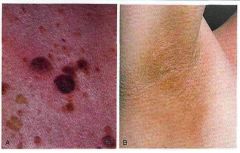
Two patients from Japan come into your office. Patient A on the left and patient B on the right. What could be the underlying cause of this?
|
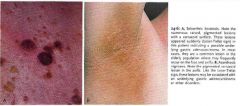
|
|
|
This is the most common benign tumor of the stomach.
|
Leiomyoma
|
|
|
There is an increased risk of primary stomach adenocarcinomas in individuals of what blood type?
|
Blood type A
|
|
|
The most important risk factor for developing intestinal type gastric carcinoma is?
|
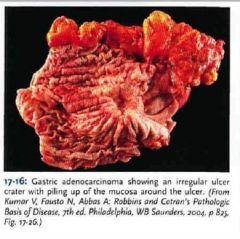
Intestinal metaplasia due to H. pylori
|
|
|
What could be a typical presentation of stomach cancer?
|
• Cachexia and weight loss (most common; 60%)
• Epigastric pain (50%) • Metastasis to left supraclavicular node (Virchow's node) |
|
|
Aside from arsenic and polycyclic hydrocarbons in cigarette smoke, this carcinogen from cigarette smoke may cause urothelial CA of the bladder.
|
Naphthylamine
|
|
|
A man in his 50's has been smoking for as long as he can remember. He presents with a painless hematuria, fatigue and malaise. He has lost weight. What could be going on?
|
Transitional cell CA of the bladder. Painless hematuria is the most common sign.
|
|
|
Nitrosamines are found in what type of beverage?
|
Beer
|
|
|
A group of workers are making plastic pipes. What cancer are the workers at risk for?
|
Angiosarcoma of the liver due to vinyl chloride exposure (PVC is in the pipes)
|
|
|
These four chemicals are carcinogens seen in occupational exposure. What are they and what can they predispose to?
|
Nickel, chromium, beryllium, silica
Lung carcinoma |
|
|
EBV is associated with what cancers?
|
(1) Nasopharyngeal carcinoma
• Clasically shows up in a chinese male. • Clasically it presents as a neck mass because the tumor early metastasizes. (2) Burkitt lymphoma • African individual (3) CNS lymphoma in AIDS |
|
|
Human herpesvirus 8 is associated with what cancer? What people get this cancer?
|
Kaposi's sarcoma. Tumor of endothelial cells.
Three subtypes of patients get this sarcoma: • Older Eastern European male (is excised) • AIDS patients (antiretroviral agents) • Transplants, because of immunosuppression. (reduce immunosuppression slightly) |
|
|
Hepatitis B virus and hepatitis C virus are implicated in the development of what cancer?
|
Hepatocellular carcinoma.
|
|
|
HBV is a _________ (DNA/RNA) virus.
|
DNA
|
|
|
HCV is a _________ (DNA/RNA) virus.
|
RNA
|
|
|
HTLV-1 is associated with what cancer?
|
Adult T-cell leukemia/lymphoma
|
|
|
High-risk HPV (e.g., subtypes 16, 18, 31, 33) are associated with what cancers?
|
• SCC of the vulva
• SCC of the vagina • SCC of the anus • SCC of the cervix • Adenocarcinoma of the cervix |
|
|
What type of radiation would be seen in a nuclear reactor accident?
|
Ionizing radiation
|
|
|
What type of radiation would be seen in radiotherapy?
|
Ionizing radiation
|
|
|
A child has been exposed to radiation in a nuclear reactor accident. What cancers could be seen in this child over time?
|
• Papillary carcinoma of the thyroid
• AML • CML |
|
|
The most common source of nonionizing radiation is _____.
|
UVB sunlight
|
|
|
UVB (nonionizing radiation) can cause what cancers?
|
• SCC of the skin
• Basal cell carcinoma of the skin • Melanoma of the skin |
|
|
UVB causes damage to DNA by ______________.
|
causing the formation of pyrimidine dimers which are normally excised by restriction endonuclease
|
|
|
DNA mutations eventually disrupt what? What is the consequence?
|
Key regulatory systems. This allows for tumor promotion (growth) and progression (spread).
|
|
|
The three key regulatory systems that may become disrupted include [...]
|
• Proto-oncogenes
• Tumor suppressor genes • Regulators of apoptosis |
|
|
What are proto-oncogenes?
|
Genes that are essential for cell growth and differentiation.
|
|
|
When a proto-oncogene mutates, it becomes a/an _________, which leads to _______________.
|
oncogene; unregulated cell growth
|
|
|
What are the key categories of oncogenes?
|
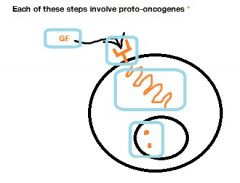
• Growth factors
• Growth factor receptors • Signal transducers • Cell cycle regulators |
|
|
Provide an example of a growth factor proto-oncogene/oncogene and its associated tumor.
|
In astrocytomas, there is a mutation leading to overexpression of PDGF beta. PDGF will stimulate the cells in an autocrine fashion.
|
|
|
What are some growth factor receptors that can be mutated and what tumors are they associated with?
|
• HER2/neu. Subset of breast CA.
• RET. MEN2A, MEN2B, sporadic medullary CA of thyroid • KIT. |
|
|
This growth factor receptor is amplified in a subset of breast cancers. What is it? What drug can be used in the treatment of these subtypes of breast cancer?
|
HER2/neu (encoded by ERBB2). Trastuzumab (herceptin).
|
|
|
What should you do in a patient suspected of having MEN2? If it comes out positive, what should be done?
|
RET study. Prophylactically remove the thyroid.
|
|
|
HER2/neu is a/an ______________(epidermal-/neural growth factor receptor).
|
epidermal growth factor receptor
|
|
|
RET is an _______________ (neural-/stem cell growth factor receptor).
|
neural growth factor receptor
|
|
|
A point mutation in what growth factor receptor is associated with GI stromal tumors?
|
KIT
|
|
|
What is probably the most important signal transducer gene family to be aware of? What does the gene transcribe?
|
RAS gene family.
GTP-binding proteins. |
|
|
RAS gene family is commonly mutated in ___________ (a few/large number) of cancers.
|
large number
Seen in CA, melanomas and lymphomas. |
|
|
RAS in its "off" state is associated with _______.
|
GDP
|
|
|
The moment that a growth factor binds to its receptor, what happens with RAS?
|
It is now associated with GTP. RAS-GTP can now send the signal further to the nucleus.
|
|
|
What helps RAS to hydrolyse GTP to GDP?
|
GAP (GTP-Associated Protein)
|
|
|
What is another important signal transducer outside of RAS? What type of transducer is it?
|
ABL. It's a tyrosine kinase.
|
|
|
When there is a t(__;__) translocation with ____, there is overactivation of this tyrosine kinase, leading to what cancers?
|
t(9;22); BCR
CML and some types of ALL. |
|
|
In what age group of patients with ALL do we see a t(9;22) translocation?
|
Adults. Poor prognosis.
|
|
|
The chromosome resulting from t(9;22) is called the ___________ chromosome
|
philadelphia
|
|
|
What is the category of proto-oncogenes for the following proteins: c-MYC, N-MYC, L-MYC.
|
Nuclear regulators. They are transcription factors.
|
|
|
The mechanism by which N-MYC and L-MYC become overactive and produce cancer is by amplification. However, for c-MYC, this mechanism involves __________.
|
translocation (t[8;14] involving IgH
|
|
|
Burkitt's lymphoma is a lymphoma of __________ (B-Cells/T-Cells)
|
B-Cells
|
|
|
Immunoglobulin heavy chain locus sits on chromosome ____.
|
14
|
|
|
One of the key histologic findings in Burkitt's lymphoma is called ____________. Describe it.
|
Starry sky appearance. Tumor cells represent the "sky", they are blue. Stars are little white areas that are interspersed (strødd inn i) between the tumor areas. White areas represent areas of macrophages eating cells that are dying. The idea is that cells are growing so rapidly (massive overproduction of myc) that they actually grow and die.
|
|
|
N-myc and L-myc are associated with what cancers?
|
• Neuroblastoma
• Lung carcinoma (small cell) |
|
|
Fill in the blank. These are categories of proto-oncogenes implicated in causing cancers: Growth factors, growth factor receptors, signaling transducers, nuclear regulators and ____________.
|
cell cycle regulators
|
|
|
What is the action of cell cycle regulators?
|
They assist movement through the cell cycle
|
|
|
What is the stage of the cell cycle that is the most highly regulated.
|
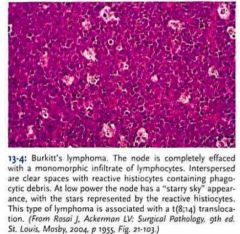
G1 to S
|
|
|
Mantle cell lymphomas are composed of B cells that resemble cells in the mantle zone of ____________.
|
Normal lymphoid follicles
|
|
|
The "B-area" of the lymph node is the __________ (cortex/paracortex/medulla)
|
cortex
|
|
|
Outside the mantle area surrounding lymphoid follicles, you can develop a region called ____________.
|
margin
|
|
|
Draw the cell cycle
|
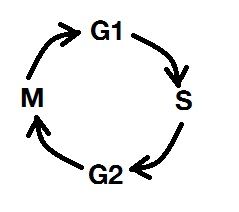
|
|
|
A 55-year old man presents with fatigue and painless lymphadenopathy. The tip of his spleen is felt on palpation. Multifocal submucosal nodules that resemble polyps are found in his GI tract. A biopsy of lymph node shows expansion of the region next to the follicle. What cancer could it be and what is the characteristic immunophenotype for this tumor?
|
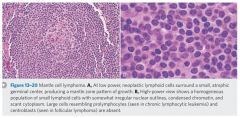
Mantle cell lymphoma. The GI involvement is characteristic.
Cyclin D1 protein overexpression due to t(11;14) translocation. Cyclin D1 promotes G1 to S. |
|
|
What neoplasms may arise in the three key B-region area of a lymph node?
|

|
|
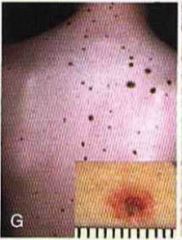
This syndrome is a risk factor for developing malignant melanoma. What is this syndrome? Give three facts.
|
Dysplastic nevus syndrome.
• Majority develop malignant melanoma. • > 100 nevi on the skin • AD |
|
|
What are the ABCD signs of melanoma?
|

|
|
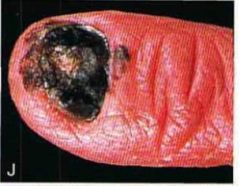
An asian man visits his local physician. He shows him his finger. The physician says that this is related to sun exposure. Is he correct? Give four facts about this condition.
|
No. This is acral lentiginous melanoma.
• 2-8% of cases • Palms/soles/nail • Most common in asians and blacks. • Poor prognosis |
|
|
For melanoma prevention you should use a sunscreen of ____.
|
> 15 SPF
|
|
|
What is the most important prognostic indicator in malignant melanoma?
|
Depth of invasion.
|
|
|
This type of melanoma is common in the elderly (4-10% of cases). It is least likely to have a vertical phase. What is it?
|
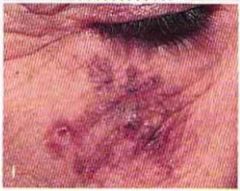
Lentigo maligna melanoma
|
|
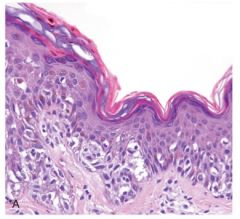
What cell cycle regulator is highly amplified in the tumor represented by the above histograph?
|
This is malignant melanoma. Cells have a radial growth (single and nests of cells in epidermis).
CDK4 is amplified. |
|
|
Compare classical features of benign and malignant tumors. Why are the listed features not sufficient to classify a tumor as benign of malignant.
|
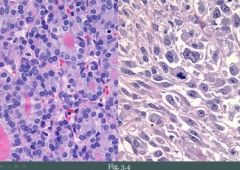
Benign:
• Slow growing • Well circumscribed • Distinct • Mobile Malignant: • Rapid growing • Poorly circumscribed • Infiltrative • Fixed to surrounding tissue Remember, malignant tumors can have benign features and vice versa. That's why these are only screening procedures. The only way to make an absolute diagnosis of CA is biopsy or excision. |
|
|
What is nuclear pleomorphism?
|
It means that some nuclei are small and some are big.
|
|
|
What are some nuclear characteristics of malignant tumors?
|
• Nuclear pleomorphism
• Nuclear hyperchromasia (dark blue) • High N:C ratio (indicates a very active cell) • High mitotic activity |
|
|
Malignant tumors and benign tumors can share each others properties to some extent. In that case, what is the absolute distinguishing feature between benign and malignant?
|
Metastatic potential
|
|
|
One important clinically useful test in the context of neoplasia is _______________.
|
immunohistochemistry
|
|
|
You look in the microscope and observe a very poorly differentiated tumor. You generate a long differential in your head (e.g., epithelial origin, sarcoma, mesenchymal origin). How do we narrow down this differential list and how does this technique work?
|
Immunohistochemistry. We take an antibody against a particular antigen and we label it with a brown stain and place the antibody on the cells.
|
|
|
What is the function of vimentin and in what type of tumor would you get a positive immunohistochemistry result from?
|
Surrounds nuclear envelope; is associated with cytoplasmic aspect of nuclear pore complex.
Mesenchymal cells have this intermediate filament so it would show up in sarcomas. |
|
|
The intermediate filment that would allow you to distinguish a poorly differentiated tumor as epithelial would be?
|
Keratin
|
|
|
The intermediate filment that would allow you to distinguish a poorly differentiated tumor as originating from muscle cells is?
|
Desmin
|
|
|
What role to desmin play in muscle?
|
Myofibrils are held in register with one another by the intermediate filament desmin,which secure the periphery of the Z disks of neighboring myofibrils to each other and attach them to the plasma membrane.
|
|
|
A neuroglial cell tumor would be positive for what intermediate filament?
|
GFAP
|
|
|
A tumor comprised of neurons would be positive for what intermediate filament?
|
Neurofilament
|
|
|
You have a carcinoma with glands in your microscope. You are concerned where it might be from. What could you do? Give examples.
|
Immunohistochemical stains:
• PSA --> Prostatic epithelium • ER (Estrogen receptor) --> Breast • Thyroglobulin --> Thyroid follicular cells • Chromogranin --> Neuroendocrine carcinomas (e.g. small cell and carcinoid) |
|
|
True or false: Small cell carcinoma and carcinoid tumor are derived from the same cell type, i.e. neuroendocrine cells.
|
True. Small cell carcinoma is the most poorly differentiated neuroendocrine tumor while carcinoid is the most well differentiated one.
|
|
|
This stain is particularly useful for melanoma.
|
S-100
|
|
|
What are serum tumor markers?
|
They are proteins released by tumor cells.
|
|
|
How can serum tumor markers be useful?
|
• As a screening test, e.g. PSA
• Monitor response to treatment • Monitoring recurrence |
|
|
You do a screening with PSA. It is severely elevated. You suspect prostate cancer. What is the next appropriate step to confirm cancer?
|
Elevated levels of tumor markers require tissue biopsy for diagnosis of carcinoma.
|
|
|
What is done after screening has suggested cancer and biopsy has shown that this is in fact cancer?
|
Grade the cancer, which is important for prognosis.
|
|
|
Grading a cancer involves asking the question: "[...]?"
|
Does the tumor look like the tissue in which it is growing?
|
|
|
Well differentiated means that a tumor ____________.
|
Resembles parent tissue
|
|
|
Poorly differentiated means that the tumor ______________.
|
does not resemble parent tissue
|
|
|
Grading takes into account what?
|
The architecture, does it resemble parent tissue?
& The nuclear features, does it resemble parent tissue? |
|
|
Grading is important for determining the _____________, however, the number one factor determining this is _________.
|
prognosis; staging
|
|
|
Staging asks the questions [...]
|
(1) How far has the cancer grown? (Size)
(2) How far has the cancer spread? (Spread) |
|
|
What system do we use for staging?
|
TNM
T - size (solid organs such as breast)/depth of invasion (tubular organs such as bowel) N - spread to regional lymph nodes (second most important prognostic factor) M - metastasis (single most important prognostic factor) |

